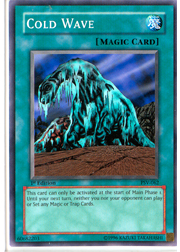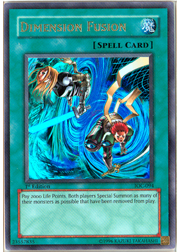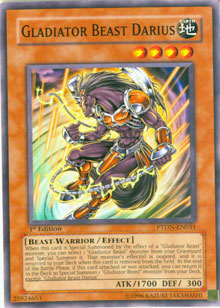 With the Light of Destruction Sneak Preview events less than three weeks out, I’ve got one week left before I’ll be setting my sights on all-new material (and man, I can’t wait). Metagame.com will begin its previews of individual cards from Light of Destruction next week, but for now I want to discuss a card that I consider to be a top pick right now: a card that’s already powerful, but that will continue to gain strength after the release of Light of Destruction. It’s no secret: speed is the key to the most successful decks in this format, and the driving forces behind that speed are almost always draw power and special summons. Those two factors are usually achieved through spell and trap cards, and Cold Wave shuts both of them down no matter what matchup you’re facing. I want to look at why it’s so good, and where I think it will make an impact in the coming weeks.
With the Light of Destruction Sneak Preview events less than three weeks out, I’ve got one week left before I’ll be setting my sights on all-new material (and man, I can’t wait). Metagame.com will begin its previews of individual cards from Light of Destruction next week, but for now I want to discuss a card that I consider to be a top pick right now: a card that’s already powerful, but that will continue to gain strength after the release of Light of Destruction. It’s no secret: speed is the key to the most successful decks in this format, and the driving forces behind that speed are almost always draw power and special summons. Those two factors are usually achieved through spell and trap cards, and Cold Wave shuts both of them down no matter what matchup you’re facing. I want to look at why it’s so good, and where I think it will make an impact in the coming weeks.
But First . . .
It helps to know what Cold Wave actually does. Since it hasn’t been reprinted since its debut in Pharaoh’s Servant, its templating doesn’t really jive with how we’d read and understand cards today. Here’s what Cold Wave says, as it was printed back in the old days:
"This card can only be activated at the start of Main Phase 1. Until your next turn, neither you nor your opponent can play or Set any Spell or Trap Cards."
The way the text reads, it might look as if Cold Wave only stops two things: the playing of spells and traps face up from each player’s hand, and the setting of spells and traps. However, Cold Wave does a lot more.
Once Cold Wave is resolved, face-down cards cannot be activated during the duration of its effect. In addition, the activation of face-up spell and trap cards that were already active on the field (like a flipped Royal Oppression) is also impossible. It’s difficult to infer this from the card’s text, but some searching through rulings resources reveals these facts. So, now that you know the full reach of this card’s effect, let’s look at how it works in a modern environment!
Cold Wave in a Combo-Oriented Format
We’ve all seen it for weeks now: strategies that draw through half the deck or more on turn 1 or turn 2, unleashing loop combos that generate burn damage or setting up a huge series of  special summons with Return from the Different Dimension or Dimension Fusion. The fastest decks in this format are quick and reliable, but they hang on a thread of spell and trap cards that they’re useless without.
special summons with Return from the Different Dimension or Dimension Fusion. The fastest decks in this format are quick and reliable, but they hang on a thread of spell and trap cards that they’re useless without.
The funny part is that in traditional TCG terms, combo decks shouldn’t be this fast. Aggressive decks that attack from the get-go have largely fallen by the wayside, because the one advantage we classically associate with aggro strategies has somehow been usurped: speed. We’re used to combo decks that take at least five or six turns (and often many more) to achieve their win condition, but with such decks going off on turn 1 a great majority of the time, the entire equilibrium between aggro, combo, and control decks has been thrown off.
Cold Wave is awesome because it sets things right. Without a flurry of draw spells like Allure of Darkness and Trade-In, Shadowpriestess of Ohm OTKs and Dark Armed Return just sit around waiting to get their spells back. Without Reasoning and Monster Gate, Diamond Dude Turbo is left in a similar position.
This scarce spell card doesn’t create a huge opening against combo decks: its effect only lasts for a single turn cycle. But the opening it makes is enough to let a well-built aggro deck get a foothold in the current duel, and that’s all a strategy like The Six Samurai or Gladiator Beasts really needs in order to have a strong shot at winning in this format.
Especially the Gladiator Beasts
The Gladiator Beast Permission deck centered around Gladiator Beast Heraklinos made its debut in the hands of players like Jake McNeely, Alex Cheruvelil, and Evan Vargas at Shonen Jump Championship Houston. The deck can win without unleashing its signature Fusion monster, and it can do some fancy things on earlier turns thanks to Test Tiger, but its real strength isn’t revealed until Heraklinos hits the field. Once he does, the Gladiator Beast player gets to decide which of the opponent’s spells and traps can be played and which will be negated. Add in a Solemn Judgment to protect Heraklinos from Snipe Hunter or Exiled Force and the permission-style lock is virtually impossible to break.
 But it’s that early game period that can be so tricky: until Heraklinos hits the field, your opponent is relatively free to do whatever he or she wants to your little Gladiator Beasts. Getting those three Gladiator Beasts onto the field is easier nowadays thanks to Gladiator Beast Darius, but the early game is still a big problem. Monster Reborn or Premature Burial can give your opponent a monster that’s big enough to control the field, while a single removal card could cost you precious turns and keep you from summoning Heraklinos.
But it’s that early game period that can be so tricky: until Heraklinos hits the field, your opponent is relatively free to do whatever he or she wants to your little Gladiator Beasts. Getting those three Gladiator Beasts onto the field is easier nowadays thanks to Gladiator Beast Darius, but the early game is still a big problem. Monster Reborn or Premature Burial can give your opponent a monster that’s big enough to control the field, while a single removal card could cost you precious turns and keep you from summoning Heraklinos.
In this type of strategy an early game Cold Wave is exactly what you need, and while players like Jake McNeely only ran two copies, I’d say the continued threat of FTK decks justifies three. With three copies of Cold Wave, you’ll have almost a 40% chance of opening with one—giving you exactly what you need to both shut down a potential FTK and keep your first Gladiator Beast on the field. Turn 2 will be free and clear as a result.
That last point begs to be explored, and it’s really important. See, a turn 1 Cold Wave is often very different from one played later in the game. Normally, Cold Wave is a balanced card: you have to activate it at the beginning of your main phase 1, meaning you won’t be able to play or set spells or traps from your hand this turn, and your opponent will be deprived in the same way on his or hers. Everyone loses the same thing, right?
Play Cold Wave on turn 1 though, and it’s a bit different. If you go first and play Cold Wave, your opponent won’t ever get a chance to set cards before your second turn, when you can attack. On that turn you’ll be free to play cards as you wish, but your opponent will have no backfield. That means that on your second turn—your first opportunity to attack—you’ll have a tremendous advantage. You wouldn’t usually have this advantage if you played Cold Wave on a later turn, because your opponent would probably have a card set already. He or she won’t be able to activate it on the turn you activate Cold Wave, but the opponent will have access to it on your turn that follows.
If you can capitalize on that second-turn advantage, the results are absolutely huge. Whatever you want to do on turn 2, your opponent won’t be able to stop you. For Gladiator Beasts, that means up to two attacks and two effects. Or, it could mean an easy Test Tiger swap for Gladiator Beast Secutor, an attack into a defense-position monster, and the easy special summoning of Gladiator Beast Heraklinos.
A couple weeks from now, when Gladiator Beasts get a power boost from Light of Destruction, a turn 1 Cold Wave will get even better. The Gladiator Beasts are going to get access to some stunning second-turn plays (Ryan Murphy will be along next week to tell you about them), and Cold Wave will let the Gladiator Beast duelists pull off their combos and unleash all their best monsters before opponents can do anything to stop them. I’m pretty convinced that if duelists try it out, Cold Wave will be an integral part of the post-Light of Destruction Gladiator Beast build. I’ve been doing the TCG equivalent of "reading ahead" and testing various Gladiator Beast builds for weeks, and I’m really happy whenever I play Cold Wave on turn 1, and follow it up with Elemental Hero Prisma on turn 2.
Beyond that, Cold Wave lends merit to virtually any battle-centric deck that wants to press early. It stops combo decks in their tracks, wrecks Gadgets, and gives the true aggro player much-needed room to breathe. It’s an amazing opening card, a great play in the early and mid-game, and a big benefit for players with the skill to use it. Keep this card in mind as Light of Destruction approaches. I expect both of the big decks to emerge from the new set play very aggressively, so Cold Wave will be a top pick.
Cold Wave returns aggro decks to their natural spot in the pantheon of strategic archetypes, and really makes them viable in combo-centric formats. If you love to bash face and think combo decks are for sissies, then tech a playset into your favorite face-smashing strategy. You won’t be disappointed.
See you next week, as we get started with Light of Destruction previews!
—Jason Grabher-Meyer